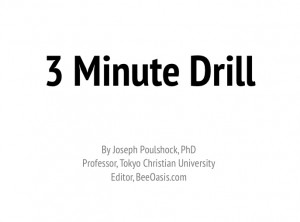 Here is iteration 3.0 of my classroom research dealing with the 5-minute drill (or 3- minute drill). Here’s the question. If students read for at least 5 minutes per day, will they actually end up reading more than that? This is a do-it-now idea that may be an antidote to procrastination. Of course, we want our students to fall in love with reading, but sometimes a little discipline helps. Like my father used to say, “Getting started is half the job.”
Here is iteration 3.0 of my classroom research dealing with the 5-minute drill (or 3- minute drill). Here’s the question. If students read for at least 5 minutes per day, will they actually end up reading more than that? This is a do-it-now idea that may be an antidote to procrastination. Of course, we want our students to fall in love with reading, but sometimes a little discipline helps. Like my father used to say, “Getting started is half the job.”
Post Category → Presentations
The 3-Minute Drill for Big, Easy Reading
Learning the AWL Online
 The Academic Word List (AWL) contains 570 word families that are probably the most important words for learners to acquire after the top 2,000 words of the General Service List (GSL). Many online resources exist for teaching the AWL, but some of them have serious pedagogical problems. They present words out of context, or the context contains words that are more difficult and less frequent that AWL words.
The Academic Word List (AWL) contains 570 word families that are probably the most important words for learners to acquire after the top 2,000 words of the General Service List (GSL). Many online resources exist for teaching the AWL, but some of them have serious pedagogical problems. They present words out of context, or the context contains words that are more difficult and less frequent that AWL words.
This presentation introduces a free website (KeyVocab.com) that presents the AWL words in quizzes and in the context of well-written and easy to parse sentences. More importantly, all the context words for the target words come primarily from the GSL top 1,000 words and secondarily from the GSL top 2,000 words. That is, all the context words are easier than the target AWL words.
The AWL words are presented in the form of short and fun quizzes of 30 words each, and learners can easily take one quiz in about 10-15 minutes. When a quiz is completed, learners can note unknown words for future review. The quizzes also contain a hint function, which can be turned on and off for each question. Currently hints are provided in Japanese, and other languages are under development, including Korean, Spanish, and Chinese.
In addition to the short quizzes, the site also provides vocabulary learning tips and short instructional videos to help learners acquire the most important academic words in a cost free, efficient, and effective way.
3-Minute Drill for ER
*Presentation at the JALT Pan-Sig on May 18, 2013, at Nanzan University, Nagoya Japan.
Research supports the claim that extensive reading (ER) helps improve all language skills. Yet in spite of the research, teachers still experience problems when they try to put ER into practice.
One serious problem is getting students to do the “extensive” part of ER. If we are lucky, students may enjoy the reading part, but to make real linguistic gains, they need to do the extensive part. And just how can teachers motivate students to read more?
Students may read more if required to read for at least 3 minutes daily. This “three-minute drill” serves as a prompt for students to read for more than three minutes, but the key is for them to read for at least 3 minutes daily.
This study looks at a group of 79 Japanese university students who practiced the three-minute for the last 40 days during the fall term of a two term academic year. Reading word count totals for the fall term were compared with the spring term when students did not do the drill. The researcher theorized that students would read more during the fall when they did the drill.
The data is correlational. Other explanations exist for why students might read more when doing the drill. But this study indicates that the three-minute drill may increase reading. This success supports the need for more research and discussion about how to improve this technique that may increase student reading and thus help improve their linguistic skills.
Note: Due to the availability of data, this presentation varied slightly from the original proposal given to the Pan-Sig. During 2013, other variations of this research deal with different data sets, comparisons, and variations of the 3-Minute Drill.

